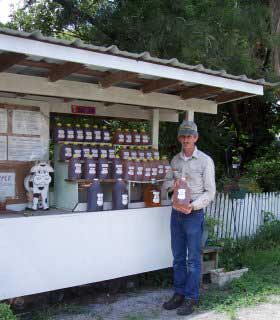
COVERING TAMPA BAY AND ITS WATERSHED |
Our subscribe page has moved! Please visit baysoundings.com/subscribe to submit your subscription request. |
|||||||||||||
A Land of Milk and Honey By Victoria Parsons South Tampa may not appear to be the ideal location to search for the abundant harvests God promised to Moses, but beekeeper Marion Lambert would disagree. "This is the land of milk and honey," he says. "It's a wonderful place for bees." For more than 30 years, Lambert has farmed a five-acre plot near Ballast Point, raising cattle and chickens along with 160 hives of honey bees, each containing anywhere from 20,000 to 100,000 bees. In terms of numbers of bees, Lambert's a small fry in an industry dominated by big players, but he harvests 300 pounds of honey per hive every year - among the highest in the industry. "There's always something blooming here, from cabbage palm and citrus to black mangroves and red bud maple," he says. Worker bees can travel from three to five miles in search of nectar, although they won't stop at just any flower. Blooms like azaleas and hybrid roses are too deep for them, he says. "It takes a couple of years to learn which floral sources they use every season." It's surprisingly easy to taste the difference in honey harvested from different sources, Lambert says, although he only labels two types. Orange blossom honey - his personal favorite - comes from moving his hives to a grove in Manatee County every spring. Everything else is labeled as wildflower honey, a darker, tastier blend that changes from month to month as different plants come into bloom. Bees as Barometers
Although honey bees are an imported species that came from Europe with early colonialists, the bees can be considered an "indicator" species that point toward the overall health of an ecosystem. "They're more susceptible to pesticides than some other species and they depend upon natural sources for food," notes Bruce Wolk, marketing director of the National Honey Board in Colorado. A regular visitor to Florida, Wolk says that unchecked growth and suburban sprawl are likely to result in fewer feral bees. "But bees are pretty resourceful creatures and they find nectar when and where they can. The real problem is the indiscriminate application of pesticides and herbicides that destroy native species. If you remove native species, the effect down the road is fewer bees which can be an indicator of a troubled ecosystem."
Nationally, bees are credited with $14.6 billion in pollination services to the nation's farmers - contributing to one of every three bites of food the average American eats. "Bees pollinate everything from strawberries and oranges to cantaloupes and watermelons." Some crops, including almonds, cranberries and melons, absolutely must be pollinated to successfully set fruit, while others benefit but not significantly. "There's no rhyme or reason to the relationship between plants and bees," Wolk adds. "Almonds absolutely require pollination but the honey is akin to motor oil. On the other hand, some of the most delicious honey comes from the thistle family which is a noxious weed." Even Brazilian peppers, which have become Florida's most invasive plant, make wonderful honey, Lambert said. Neighbors Not Necessarily Aware While many people fear bees, Lambert says wasps and hornets are more likely to sting and their stings are more likely to hurt. "A bee can only sting once and then it dies. It hurts like heck for about 30 seconds, but pretty much goes away after that. A wasp or hornet can sting many times and they'll actually chase someone once they start stinging." And while African killer bees may make great movies, they're not likely to become a real problem in Florida, he said. Africanized bees migrating north from Central America have become hybridized with local bees and lost much of their mean streak along the way. In Tampa and near other major ports, "trap hives" are set with pheromones to attract bees that may have hitched a ride on a ship, then periodically checked - including DNA testing - to ensure that they are not aggressive.
Lambert purchases Italian queen bees from a producer in Georgia because they're typically calmer than other species. That doesn't mean they're friendly though. "Bees are like alligators with wings," he says. Soggy wet summers - like this one - make them even more likely to sting because mature worker bees are forced to stay close to home when it rains. Visitors are draped from head to toe in heavy-duty cotton coveralls, but Lambert typically wears just a helmet and net that protect his head and face with blue jeans and a long-sleeved shirt. A puff of smoke before opening the hives temporarily distracts the bees while he checks on their health, levels of honey and the status of the queen. Honey is harvested on a monthly basis and minimally processed without heat to preserve its natural enzymes. While most of his harvest is sold in 55-gallon barrels to a wholesaler in Belleview, he also operates an honor stand in his front yard where buyers can slide $10 into a box and take home a quart of honey. "That's the way people used to do things, and it still works," he says. "I get an occasional pilferer but most people are still basically honest."
|
||||||||||||||
|
||||||||||||||
|
© 2005 Bay Soundings
|
||||||||||||||






